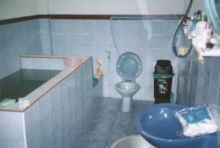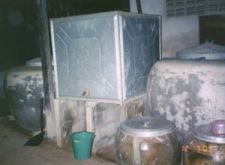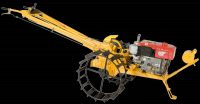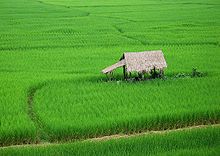Steve and Jemjahn go to Thailand, 2003
5. Jem's Old Home in the Village
10. Impressions of the Village
22. Thai People, My Impressions
5. Jem's Home in Thailand
The sun came up just after we arrived in the village. Determined to get over jet lag as quickly as possible, Jem and I started the day as if we hadn’t just traveled 12,000 miles in the previous 24 hours.
The first thing to do was get introduced to our quarters.
The house was
built about ten years ago, most of the money from J em,
for her elderly mother. It was built in the Thai style, ie, of wood,
with much of it elevated so animals could live underneath. Over the
years, improvements and additions were made, to where the house now has
a tiled Western-style bathroom in addition to the original outhouse. A
spare but comfortable kitchen allows food to be prepared when it’s
raining, and the "patio" under the bedroom is quite comfortable, with a
concrete floor and screened area to keep out the flies.
em,
for her elderly mother. It was built in the Thai style, ie, of wood,
with much of it elevated so animals could live underneath. Over the
years, improvements and additions were made, to where the house now has
a tiled Western-style bathroom in addition to the original outhouse. A
spare but comfortable kitchen allows food to be prepared when it’s
raining, and the "patio" under the bedroom is quite comfortable, with a
concrete floor and screened area to keep out the flies.
Except for the location – that is, in the village, with neighbors too close -- I could live there.
That's because in the 35 years since I'd married Jem, the village had acquired electricity.
Until then, the village folk lived much as their ancestors did centuries earlier.
Sure, they had the
plastic bucket, the bicycle, the aluminum pot, but stop for a moment and
imagine life without electricity. No refrigerators, no televisions. No
lights after dark.

Drinking water carried from the temple pond in buckets at the end of a bamboo pole across your shoulders. Or caught in huge clay jars when it rained.
Working your rice fields with water buffaloes.
A phone booth at the town's intersection, the only phone in the village.
Today it's all changed.
Today, there’s
electricity in the village. Running water, too, piped and metered to
houses from the temple's pond, where the water is first pumped to a
large, tall tank for pressure. Most nights about nine the water gets
turned off, but throughout the day it’s usually there at the turn of a
faucet, something magical we in the West take for granted.

The water
buffaloes are mostly gone now, replaced by machines. To my last breath I
will never forget my first hours in Thailand, on April 1, 1968. We
landed at the airport outside the city, then piled onto an Army bus for
Bangkok. I spent the entire drive with my face pressed to the window,
thinking I had fallen asleep and woke in the middle of a film called
 “Ridiculously
Scenic Third World Countries.” Most of the slow drive to the city was
past fields of the deepest green. Occasionally a child sitting on the
back of a water buffalo waved to us.
“Ridiculously
Scenic Third World Countries.” Most of the slow drive to the city was
past fields of the deepest green. Occasionally a child sitting on the
back of a water buffalo waved to us.
At the height of the Vietnam War, two months after the start of the Tet Offensive, the Army had assigned me to Paradise.
On our trip this year, the drive between the airport and Bangkok has no green fields, no water buffalo. Just a 20-mile unbroken, unrelenting line of concrete buildings. The water buffalo are gone, I was told, from most of Thailand. Once in a while in our two weeks I saw a few, but not like in the late 60s, when they were everywhere, as much a part of the landscape as the trees and klongs (canals), and adding so much charm to the countryside.
As the eldest child, Jem had the responsibility of tending to the family’s most valuable possession, its water buffaloes. She would lie down with them in the fields for a nap, resting on their bellies. She survived a flooded river by hanging on to a tail for dear life. She became very close to them, as if they were pets, not beasts of burden. I picture her sitting on a buffalo’s back, her hair in pigtails, the sun behind her low in the sky as she winds her way home.
During our few days in the city, I tried to find a figurine of a water buffalo, a perfect gift for her. Of more than a dozen shops I went into, all had elephants, but only two had water buffaloes. One was supposedly made of jade, which for the low price didn’t seem possible, and was crudely carved. The other was carved with even less care of some light wood and given painted yellow, almost comical, eyes. The sturdy beasts of Thailand have disappeared, both from the Thai landscape and from the Thai consciousness.
I join Jem in deeply regretting it.
Back when I brought Jemjahn to America, I took a 15th century girl almost straight to the 20th, with very little chance in between to acclimatize. I’m proud of my own Eliza Doolittle. She adapted well to her new culture without losing the best values of her old.
next: New Rice Storage House